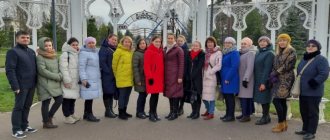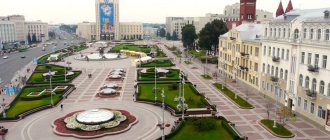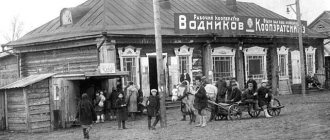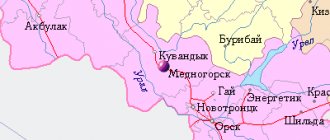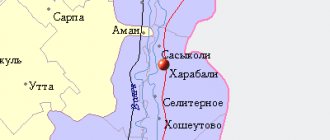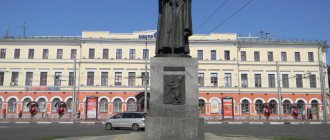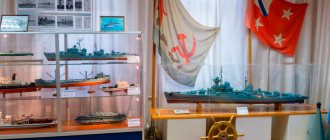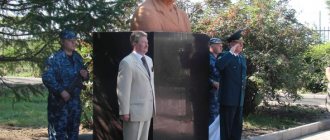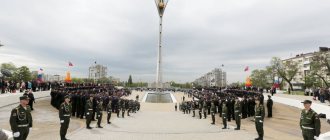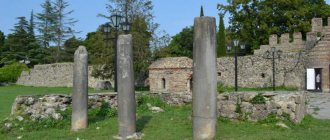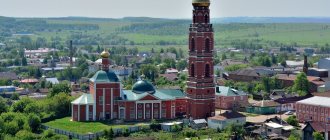Year of foundation: 1781
Nazran celebrates City Day on
the 3rd Sunday of October
.
In 2022,
this date is
October 16
.
City Gate
Nazran
- the administrative center of the Nazran district of Ingushetia, its largest city. One of the few Russian regional cities that is larger in population than the capital of its subject of the Federation is Magas.
The city was the capital of Ingushetia until 2000, when the capital was moved to the specially built city of Magas, located 4 km from Nazran.
The city of Nazran is located in the west of the Chechen foothill plain. Distance to Moscow – 1916 km. The railway station is located on the Rostov-on-Don - Baku line. Highway – Rostov-on-Don – Baku.
The Ingush call Nazran “Nana-Nasare” - Mother Nazran
.
People have lived on the lands of the Nazran Valley since ancient times. The first settlements in this territory date back to the fortieth millennium BC. Numerous monuments dating from the 3rd to 1st millennium BC have been recorded here. A settlement dating back to the end of the 2nd millennium BC was discovered on the southeastern outskirts of the Nasyr-Kort district. Until the 13th century, on the territory of Nazran there were five ancient settlements and two settlements of the Alan era (5th-13th centuries), as well as the Alanian city of Dadakov, burned by the Mongols in February 1278. Russian fortress of the early 19th century During difficult historical periods, when the territory was captured by stronger conquerors, the residents of the Nazran Valley went to the mountains, but returned to their homeland at the first opportunity.
Official founding date
Nazran dates back to
1781
, when the Ingush post on a high cape between the Sunzha and Nazranka rivers was noted by L. Shteder. The decision on this historical determination of the founding date of the city was made at a scientific and practical conference held by the city administration in the summer of 2000.
Nazran was first mentioned in an official document on June 5, 1810. On August 22, 1810, in Vladikavkaz, representatives of six clans living in Nazran signed an act on the accession of the Nazran society to Russian citizenship. In the fall of this year, the Nazran redoubt was founded. In 1817, 1832 and 1842 the fortress was rebuilt and strengthened. In 1868, the first secular educational institution in Ingushetia was established - the Nazran Mountain School.
On the territory of Nazran there are several dozen historical and cultural monuments. These are human sites and Stone Age workshops, mounds and other burial structures of various eras, fortifications and settlements, ramparts and ditches dating back to the Koban and Alan periods, the Borga-Kash mausoleum of the early 15th century, the Russian fortress of the early 19th century, the ruins of the Ovlurg tower of the early 19th century centuries, monuments dedicated to political, public and religious figures, soldiers who died in the Second World War, a memorial to the victims of political repression.
Residence of the President of the Republic of Ingushetia
The symbol of Nazran is acacia. Acacia is a resilient tree. No troubles that befell the city broke it.
Modern Nazran is developing dynamically; in almost a few years the city has changed beyond recognition, and the population has increased significantly. Today the city's population is more than 124 thousand people (2020).
Nazran periodically becomes the venue for All-Russian tournaments in judo, boxing, football and cycling, as there are two modern, well-equipped stadiums here.
Day of the city
in Nazran it is celebrated in the fall.
What to see in Nazran first
It is believed that Nazran was founded in 1781, although the history of these places is much older. There are many historical monuments and other various attractions on the territory of the city and the Nazran district it heads, but first, about the most famous of them.
Nazran fortress
- Address: I. Zyazikov street.
In the 19th century, during the Caucasian War, a fortress of the Russian imperial army was built on the territory where the Ingush security post was located. Its purpose was to protect the local population, and it was built with the participation of the inhabitants of these lands. Construction was completed in 1817.
The fortress remembers the outstanding people of Russian history and culture who visited it. Among them are the poet and playwright A.S. Griboyedov, who stopped in Nazran on his way to Persia, Decembrist E.E. Lachinov, academician and painter G. Gagarin, who owns several artistic images of this fortification.
The fortress, considered a unique architectural monument, has only partially survived to this day. However, it can be considered the heart of Nazran. It is recognized as the main historical attraction of the flat part of Ingushetia. Today, city blocks are located inside the dilapidated walls.
Ingush State Museum of Local Lore
- Address: st. Oskanova, 23.
The main museum not only of the city, but of the entire republic traces its history back to 1972. Its founder, Tugan Khadzhimokhovich Malsagov, is a veteran of the Great Patriotic War, a local historian and a great patriot of his region, who made a huge contribution to search work and perpetuating the memory of the fallen. Today the museum bears the name of this man.
Two of the six halls of the museum are dedicated to the military theme - one of them is called the “Hall of the Great Patriotic War”, the second is the “Small Hall of Heroes”. In addition, the museum presents an archaeological and ethnographic theme, as well as an exhibition dedicated to Islamic figures - the hall of spiritual leaders.
The museum fund of the attraction consists of more than 14,000 exhibits. The museum also preserves traces of modern cultural figures, for example, the famous poet S.V. Mikhalkov. As a souvenir of himself, the writer left the text of the Soviet anthem written by him with an autograph.
Memorial of Memory and Glory
- Address: Memory Alley.
A huge complex dedicated to significant and tragic events in the history of the Ingush people and our entire country appeared in Nazran in 2010, becoming one of the symbols of the city. The Memorial of Memory and Glory includes architectural and sculptural objects and several museum exhibitions.
The central part of the memorial is a round platform decorated with two colonnades. Near them there are marble slabs with the names of prominent people.
One side is dedicated to representatives of the Ingush people who received state awards during the period of the Russian Empire. The second - to famous figures of culture, religion, politics who contributed to the development of Ingushetia, among them Patriarch Alexy II, philologist D.S. Likhachev and many others. The Walk of Fame is planted along the circumference around the site, on which monuments of military and heroic themes are installed.
Memorial-museum to victims of political repression “Nine Towers”
- Address: Bakinskaya street.
Back in 1997, near the place where the huge complex is now located, an interesting structure appeared, known as a memorial to the victims of political repression. It is also called "Nine Towers". With the advent of the Memorial Park of Memory and Glory, the existing facility became part of it.
The popular name of the memorial speaks for itself. It consists of architectural elements traditional for the architecture of the Ingush highlanders - 9 towers. Among its peers, the twenty-meter central tower with four floors stands out.
The architectural appearance of the building correlates with the Gothic style, but the main idea was to combine the traditions of Ingush architecture from different eras. This design was created by Murad Polonkoev, a famous architect who has the title of Honored Artist of the Russian Federation. For the creation of the “Nine Towers” memorial, the master was awarded a medal by the Academy of Arts.
The memorial refers to an important historical event of the war period for the region - the deportation of the Ingush in 1944, the opening was timed to coincide with the next anniversary. Inside the “tower complex” there is a museum exhibition that reveals various aspects related to the repressions of the 30s, 40s and 50s.
Shadi Factory
- Address: Chechenskaya street, 5.
An unusual modern landmark of the city has become an industrial enterprise that produces various products from a material that is considered waste in everyday life - fish skin. The author of the new technology is a local enthusiast, leather worker and entrepreneur Akhmed Shadiev.
Having opened in 2007, the Shadi factory has already become a recognizable brand not only in the city and region, but also outside Ingushetia. Shoes, accessories and other useful items made from fish skin have become an excellent option for tourists for an unusual gift or souvenir in memory of their visit to Nazran. You can purchase products in the company's company store.
Head of Ingushetia
In the period from 1929-1991, Ingushetia was united with the Chechen Republic and formed the Chechen-Ingush Autonomous Soviet Socialist Republic. After which Ingushetia left the Chechen Autonomous Soviet Socialist Republic.
Ruslan Aushev is the first president of Ingushetia. Born October 29, 1954.
He ruled the republic from 1993 to 2002. He founded the city of the sun - Magas. Politician and public figure in Russia.
In addition, he is the chairman of the Committee on the Affairs of Internationalist Soldiers under the Council of Heads of Government of the CIS.
Hero of the Soviet Union.
Took part in rescuing children in Beslan.
Murat Zyazikov took office as president in 2002. Ruled from 2002 to 2008.
Lieutenant General, statesman.
Born September 10, 1957.
Doctor of philosophical science.
From 2008 to 2012 he was an adviser to the President of the Russian Federation.
Since October 2012 - Deputy Plenipotentiary Representative of the President of the Russian Federation in the Central Federal District.
Yunus-Bek Yevkurov became the new president of Ingushetia in 2008, who launched a campaign to improve the situation in the region.
Since January 1, 2011, the highest official of Ingushetia is called the “Head of Ingushetia”, and not the president, as was previously the case.
Hero of the Russian Federation.
Member of the Supreme Council of the United Russia party.
Historical sights of Nazran
The most interesting places in Nazran and its surroundings also include those associated with the historical past of the region.
Mausoleum of Borg-Kash
- Coordinates on the map: 43.300735, 44.844308.
One of the oldest monuments of Islamic culture in Ingushetia that has survived to this day is a 15th-century tomb. The facility is located in the vicinity of Nazran, near the village of Plievo. The mausoleum keeps many secrets. There are Arabic inscriptions above the entrance, according to which a certain Bek-Sultan rests here.
The date of construction is indicated as 808 according to the Islamic calendar, which corresponds to 1405-1406 years from the Nativity of Christ. Borga-Kash has repeatedly become the object of scientific study; it still leaves enormous room for speculation and controversy. Included in the list of cultural objects of federal significance.
Gamurzievskoye settlement
- Address: s. Barsuki, Nazran district.
The former village of Gamurzievo is today an urban area in the center of Nazran. Here, on the territory of the Nazran fortress, between the banks of two rivers - Nazranka and Sunzha - there is a large archaeological monument, a settlement that preserves evidence of various eras that the region faced.
Layers dating back to the Bronze and Iron Ages and the early Middle Ages have been discovered. The dating of the finds and household items discovered here varies from the 5th-4th centuries BC to the 10th-12th centuries. n. e. All this allowed scientists to conclude that settlements existed on the territory of modern Nazran from ancient times.
Mound Abi-Guv
- Address: Vazovskaya street.
The six-meter-high mound is an archaeological site of Nazran, located not far from the Caucasus federal highway.
Scientists date it to the third millennium BC, the Late Bronze Age, and attribute it to the Maykop archaeological culture. The name of the mound is associated with the legend of the “Ingush Amazon” named Abi, a woman who managed to repel the enemy.
Abi-Guv became an important historical place for Ingushetia in later periods. It was the site of traditional folk gatherings.
Barsukinskaya water mill
- Address: village Barsuki.
In the village of Barsuki, which is part of the Nazran district, an interesting ethnographic monument of the 19th century has been preserved. The wooden water mill was an important element of the livelihoods of the local population, supplying flour to the surrounding settlements. It performed its functions until the 1970s. According to a decree of 2001, the mill is recognized as an object of culture and history of regional significance.
Fortified area of ancient settlements in Surkhakhi
- Address: Surkhakhi village.
The village of Surkhakhi, Nazran district, is of great tourist interest due to the attractions located here. Near it there is an ancient archaeological complex consisting of 30 settlements, between which burial sites are located.
Settlements are fortified by defensive belts consisting of fortresses and watchtowers. The fortified area of the fortifications is located on a hill and covers an area of more than 100 square meters. km.
Capital of Ingushetia
The capital of the Republic of Ingushetia is Magas - the city of the sun. The city of Magas is located 4,000 meters southeast of Nazran (the former capital of Ingushetia) and 500 meters from the border of Ingushetia with Ossetia. Magas is one of the most sparsely populated cities in Russia, as well as the youngest city. Magas was the name of the capital of the ancient Alanian state. An Arab author of the 10th century first mentions the city in his work “Muruj az-zahab” (Golden Origins). The city was founded in 1995 by Ruslan Aushev. On December 26, 2000, Magas became the capital of Ingushetia.
Monuments and memorials in Nazran
Most of the noteworthy monuments are located on the territory of the Memorial of Memory and Glory. But there are some other sculptural and monumental objects in Nazran that attract the attention of tourists and are among the symbols of the city. Below are the most interesting city monuments.
Stele at the entrance to the city
- Address: R-217 Caucasus, 569th kilometer.
Everyone who comes to Nazran is greeted by a structure shaped like a horseshoe. It is installed in the center of the road ring. Inside the figure there is a solar sign and a tablet with the name of the city and the date of its foundation. The stela became one of the significant identification symbols of Nazran.
Monument to the last defender of the Brest Fortress
- Address: Memorial.
Umat-Girey Barkhanoev is an Ingush by birth, a senior lieutenant, a soldier of the Great Patriotic War, who was destined to die at the very beginning of the war. He participated in the legendary defense of the Brest Fortress and is revered in his homeland as its last defender, although according to official data, Pyotr Mayorov went down in history with this status.
Probably Barkhanoev was the last of the 90 Ingush who defended the famous outpost, as evidenced by the plaque on the monument. The figure of the fighter, depicted against the background of the ruins of the fortress wall, was installed on the territory of the Memorial of Memory and Glory.
Monument to Kartskhal Malsagov
- Address: square named after Kartskhal Malsagov.
Kartskhal Ortskhanovich Malsagov is considered the founder of the city of Nazran. For Ingushetia, he is a legendary and revered figure. The monument to the “great son of the Ingush people” appeared in 2013. An equestrian statue by Ali Magomedov stands next to the Assa Hotel in a picturesque park.
Monument to the Ingush cavalry regiment "Wild Division"
- Address: Memorial.
In June 2012, a recognizable sculptural composition depicting three horsemen appeared as part of the Memorial of Memory and Glory. It is dedicated to an important episode of the Ingush military history of the period of the Russian Empire, namely the Ingush regiment that served as part of the Caucasian Cavalry Division. This is the first monument in Russia to immortalize this military formation. The monument was created by Ravil Yusupov and Alexey Ivanov.
Train from the time of the deportation of the Ingush in 1944
- Address: Memorial.
An important component of the Memorial of Memory and Glory is the train, consisting of a heated carriage and locomotive “L-2046”. Representatives of the Ingush people were forcibly taken out on such trains in 1944. This is a reminder to contemporaries of the tragic period of deportation and persecution.
Facts about Ingushetia
- The geographical center of the Caucasus is Ingushetia
- Vladikavkaz (Ingush name - Buro) was the capital of Ingushetia until 1933
- The natives of Ingushetia are the Ingush, who call themselves galgai (Galgai)
- The first Hero of Russia - S.S. Oskanov
- March 1 is Dzhigit Day, an official holiday in Ingushetia, where Defender of the Fatherland Day is not celebrated (February 23 is the day of deportation of the Ingush people).
- The purest oil in the world, from which aviation oils are made, is produced in Ingushetia.
- The most important task of Ingushetia is the return by political means of the territory illegally seized from Ingushetia and the preservation of the territorial integrity of the Republic of Ingushetia, in accordance with the constitution of the republic.
- More facts - here.
Religious places and architecture of the city of Nazran
Islam occupies an important place in the culture of the Ingush Republic. The main religious attractions in Nazran and its environs belong to this religious denomination. These include both temples-mosques and holy places significant for the spiritual history of the Ingush people.
Duan-Guv. Mountain of prayers
- GPS coordinates: 43.235129, 44.808385.
Duan-Guv is a place of great religious and historical significance for all of Ingushetia and its people. It is associated with the name of Sheikh Kunta Hadji Kishiev. It was he who performed the first prayer in the Ingush lands on the mountain, calling on the population to accept the faith of Allah. This was in 1847.
In 2000, a monument in the form of a huge stone was erected on the Mountain of Prayer, one side of it is unhewn, the other depicts characteristic Muslim symbols and a granite slab is placed on which the events that gave rise to Islam in the region are set out.
Holy spring founded by Kunta Hadji Kishiev
- Address: Mount Duan Guv.
After the first prayer in the history of Ingushetia in 1847, it was necessary to perform the ritual of ablution. The second holy place is connected with this - a natural spring discovered by Kunta Haji at the very moment when the population wondered where to get water for the ritual. The sheikh touched the ground, dug a little and knocked out a key from there. This semi-legendary story is associated with a holy place in the former village of Gamurzievo, and now within the city of Nazran.
Central Mosque named after. Magomed-Basira Ozdoeva
- Address: Ingushskaya st., 18.
The majestic religious building on Ingushskaya Street in Nazran is the main city mosque, which has the status of a cathedral. This is a building of the present century, erected in the early 2000s. The mosque is dedicated to a religious figure of early post-Soviet history. The year 1992 was marked by the Ossetian-Ingush military conflict. 33-year-old Magomed Basir Ozdoev did not remain indifferent to him and died from a sniper bullet.
Nasyr-Kort Mosque
- Address: s. Nasyr-Court.
The oldest mosque on the territory of Nazran, a monument of history and architecture of the last quarter of the 19th century. Built in the 1880s. The only mosque that managed to avoid closure in the 1930s. In our time, a significant religious monument was included in news reports in 2016, when a passenger car belonging to the imam exploded near it.
Mosque in the village of Barsuki
- Address: village Barsuki.
The surrounding Badgers can boast of a beautiful mosque. The religious building dates back to 1901. Its construction was financed by the Azerbaijani Persian Sey-Ali Mukhtarov. After closing in the 1930s, the building was used as a warehouse. Returned to the religious community in 1977 with the assistance of the secretary of the local district committee, Seradzhin Bekov. Restoration was carried out before opening.
Mosque in the village of Ekazhevo
- Address: Ekazhevo village, Dzhabagiev street.
In 2014, a large village located between the two main Ingush cities acquired a new mosque. A beautiful building in bed colors with gilding replaced the previous religious building, which was destroyed in a fire in 2006. The height of the minaret is 46 meters. The mosque can accommodate more than 4,500 thousand people. This miracle was built with donations from local residents.
Mosque and ziyarat of Batal-Hadji Belkhoroev in Surkhakhi
- Address: Surkhakhi village.
Already at the entrance to the village of Surkhakhi one of its main attractions is visible - a magnificent sand-colored mosque. The entrance to it is preceded by a beautifully decorated gate.
There is an Islamic cemetery on the premises. Here is the ziyarat, that is, the burial place of a significant religious figure at the turn of the 19th-20th centuries. Chechen-Ingush sheikh Batal-Khadzhi Belkhoroev. The mosque is named after him.
Coat of arms of Ingushetia
The coat of arms was adopted on August 26, 1994. This is a circle in the central part of which an eagle with open wings is drawn, which is a symbol of courage, fidelity and wisdom. The Ovlur battle tower is also depicted there, located against the backdrop of the Caucasus Mountains. To the left of the tower is Table Mountain, and to the right is Mount Kazbek. Above this entire picture is a semicircle of the Sun, which is at its zenith and emits 7 straight rays going down. At the bottom of the coat of arms there is a solar sign, which is also on the flag. The coat of arms is decorated with 5 colors: golden, blue, red, green and white.
Culture, sports and leisure for tourists in Nazran
Nazran is the center of cultural life in the region; cultural and leisure institutions that are significant for the republic are located here.
Russian State Musical and Drama Theater of the Republic of Ingushetia
- Address: st. Asiyat Tutaeva, 44.
The traditions of European and Russian theater on Ingush soil are embodied by a cultural institution that emerged in 1998. The professional theater grew out of the Sovremennik studio, created by graduates of the Shchukin School.
The youngest theater in the region already earned gold at the Delphic Games at the turn of the millennium. During its existence, it managed to become an important component of the cultural image of the region, gaining fame far beyond the borders of the republic.
Ingush State Theater for Young Spectators
- Address: st. Asiyat Tutaeva, 44.
Youth Theater of the Republic of Ingushetia is the heir and follower of the puppet theater, created back in 1969 in the city of Grozny. It included three national troupes and was called the Chechen-Ingush Puppet Theater.
After the separation of Ingushetia from Chechnya, the puppet theater moved to Nazran, in 1998 it was transformed into a theater for young spectators, since then its repertoire has not been limited exclusively to puppet performances.
Ingush State Drama Theater
- Address: Fabrichnaya st., 9.
An institution with a rich theatrical tradition began with a folk troupe organized in the 1920s. On its basis, the Chechen-Ingush Drama Theater arose, which included an Ingush troupe that staged many classical plays in the Soviet years.
Her legacy formed the basis of the theater, which moved to Nazran after the formation of Ingushetia. The theater was named after the poet, playwright and translator Idris Murtuzovich Bazorkin, in whose honor one of the central streets of Nazran is named.
Sports Palace named after. Berda Evloeva
- Address: Dzhabagieva street.
Berd Evloev is an athlete of the beginning of the last century, representing the discipline of freestyle wrestling. One of the main sports grounds in Ingushetia is named after this illustrious personality.
The palace, opened in 2016, specializes in sports such as boxing and acrobatics in addition to wrestling. There are two sites with spectator seats where competitions and public events are held.
Ice Palace "Erzi"
- Address: Dzhabagieva street.
The Erzi Ice Palace became the arena for winter sports in Nazran. Its opening in 2015 saved Ingush hockey players from having to travel to Vladikavkaz for training. Now the local hockey team trains here.
Figure skating is also developing at the palace, relevant sections operate and competitions take place. Residents and guests of the region have the opportunity to go out on the ice to simply skate and spend their leisure time. The sports complex also has a gym and acrobatic gym.
See also the sights of other cities-centers of the Caucasus:
- Nalchik, Stavropol, Maykop, Makhachkala,
- Vladikavkaz, Cherkessk, Pyatigorsk.
Nazran is a colorful city where ancient history and vibrant, developing modernity are surprisingly combined. Not a single route in Ingushetia runs past this settlement. Nazran is considered the starting point of the route to the so-called Mountain Ingushetia - an attractive region for tourists, replete with ancient monuments, located nearby.
Photos of Ingushetia
All materials from photographer Evgeny Shivtsov:
Memorial of Memory and Glory
Mountains of Ingushetia
Magas is the capital of Ingushetia
Mountains
Mountain Ingushetia
